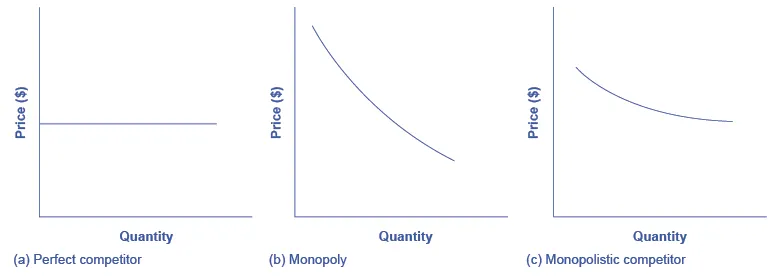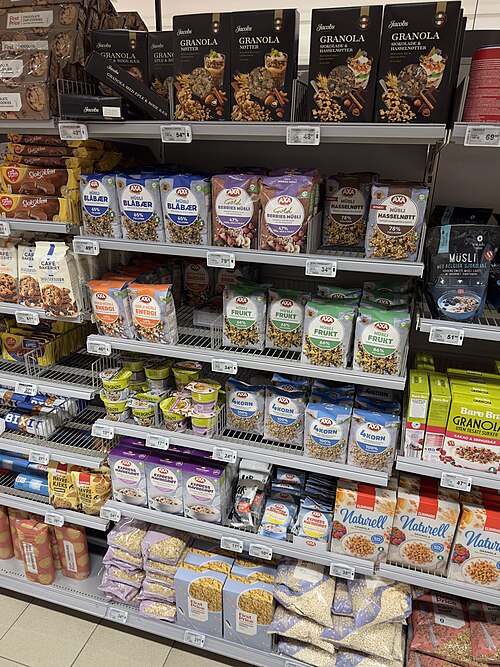AQA Specification focus:
‘Monopolistically competitive markets will be subject to non-price competition.’
Non-price competition and product differentiation are central to monopolistic competition, where firms seek to attract consumers through unique features, branding, and service, rather than solely lowering prices.
Understanding Non-Price Competition
In monopolistic competition, firms face downward-sloping demand curves due to product differentiation. Unlike perfect competition, where goods are identical, firms in monopolistic competition compete by distinguishing their offerings.

Perceived demand under monopolistic competition slopes downward because differentiation gives each firm limited pricing power. The curve is more elastic than a monopolist’s curve due to close substitutes. Source
Non-Price Competition: Strategies used by firms to increase demand without altering price, typically involving marketing, branding, product quality, customer service, and innovation.
Non-price competition allows firms to build brand loyalty, reduce the price elasticity of demand for their products, and achieve some degree of market power despite the ease of entry.
Main Methods of Non-Price Competition
Firms commonly compete through:
Advertising and Branding: Creating brand awareness and loyalty.
Product Differentiation: Varying design, style, or features to stand out.
Customer Service: Offering better after-sales support, delivery, or warranties.
Quality Improvements: Enhancing durability, performance, or sustainability.
Innovation: Developing new product lines or variations.
Each method increases consumer willingness to pay, effectively shifting the firm’s demand curve outward and making it less elastic.

A labelled demand curve illustrating price elasticity of demand. Branding and quality improvements reduce elasticity, giving firms greater pricing power. Formula notation is included for context. Source
Product Differentiation
Product differentiation is a defining characteristic of monopolistic competition. Firms distinguish their products to reduce substitutability and attract particular consumer segments.
Product Differentiation: The process of distinguishing a product from competitors through design, quality, branding, or functionality to create perceived uniqueness.
Product differentiation can be real (based on tangible features) or perceived (based on image, reputation, or brand positioning).

A supermarket cereal aisle illustrating horizontal differentiation and branding. Non-price attributes like flavour, packaging, and reputation reduce substitutability and make demand less elastic. Source
Types of Product Differentiation
Physical differentiation: Variations in design, size, flavour, packaging, or durability.
Service differentiation: Faster delivery, personalisation, or extended guarantees.
Location differentiation: Accessibility and convenience, such as proximity to consumers.
Brand image differentiation: Building reputation, often through long-term advertising campaigns.
Impact on Market Outcomes
Non-price competition affects firm behaviour and market performance in several ways:
Demand Curve Effects
Product differentiation makes demand less elastic, allowing firms to charge higher prices than in perfect competition.
Strong branding can make consumers willing to pay a premium.
Cost Implications
Non-price competition often involves higher costs:
Advertising and promotion raise fixed costs.
Quality improvements and R&D increase variable and capital costs.
However, successful differentiation can offset these costs by sustaining sales and higher margins.
Short-Run Outcomes
In the short run, non-price competition enables firms to earn supernormal profits if differentiation is effective. Consumers are drawn to unique features, even at slightly higher prices.
Long-Run Outcomes
In the long run, freedom of entry and exit in monopolistic competition drives profits toward normal levels. New firms imitate successful differentiation strategies, intensifying competition.
Supernormal profits attract entrants.
Entry erodes demand for existing firms until only normal profits remain.
Thus, while non-price competition can sustain demand, it cannot guarantee long-term abnormal profit due to competitive pressures.
Advantages of Non-Price Competition
Consumer choice: Greater product variety and customisation.
Innovation: Firms continually seek improvements.
Higher quality: Competitive pressure drives service and product enhancements.
Brand loyalty: Reduces switching costs for consumers.
Disadvantages of Non-Price Competition
Higher costs: Advertising and R&D increase firm expenses.
Inefficiency: Resources may be misallocated to branding instead of productive uses.
Market fragmentation: Too much product variety can confuse consumers.
Barriers to entry: Strong branding may deter new competitors despite theoretical ease of entry.
Non-Price Competition vs Price Competition
Price competition reduces prices to win customers, often leading to price wars and squeezed margins.
Non-price competition shifts focus to differentiation, sustaining higher prices and profits while avoiding destructive pricing strategies.
Both strategies are interdependent: firms often combine moderate pricing with strong differentiation.
Evaluation and Real-World Applications
Monopolistically competitive firms in industries such as restaurants, clothing, consumer electronics, and personal care rely heavily on non-price competition. For instance:
Fast-food chains differentiate via menu variety, service speed, and brand image.
Smartphone manufacturers highlight design, operating systems, and app ecosystems.
Non-price competition is essential in such markets because purely lowering prices would not secure long-term advantage due to ease of entry and imitation.
Ultimately, the balance between differentiation and cost efficiency determines a firm’s survival. Successful firms maintain consumer loyalty while adapting innovation strategies to retain their competitive edge.
FAQ
Non-price competition builds loyalty by creating emotional or habitual ties to a product beyond price. Once customers associate a brand with quality or status, they are less likely to switch even if prices rise.
This reduces the effectiveness of rival firms’ pricing strategies and gives firms greater market stability in the long term.
Advertising shapes consumer perceptions by highlighting unique features or reinforcing brand identity.
It increases awareness of differences between products, even if these are small.
By strengthening perceived uniqueness, advertising reduces the likelihood that consumers will view rival goods as close substitutes.
This makes demand less responsive to price changes.
Yes. Firms often spend heavily on branding, packaging, or promotion rather than lowering costs.
These expenditures do not always increase productive efficiency and may divert resources away from innovation or technology. In extreme cases, excessive product variety confuses consumers and contributes little to welfare.
Real differentiation arises from tangible differences such as taste, durability, or design.
Perceived differentiation, by contrast, is created through branding, packaging, or advertising that shapes consumer attitudes without necessarily changing the product itself. Both can reduce elasticity of demand, but only real differentiation changes the product’s intrinsic qualities.
In the short run, differentiated products allow firms to earn supernormal profits.
However, free entry encourages new firms to imitate successful strategies, gradually eroding demand for existing products. As rivals copy branding or service models, competition intensifies and profits return to normal in the long run.
Practice Questions
Define non-price competition and give one example of how a firm in monopolistic competition might use it. (2 marks)
1 mark for a correct definition of non-price competition: strategies used by firms to increase demand without altering the price (e.g. branding, quality, service).
1 mark for a valid example, such as advertising, improving customer service, or product innovation.
Explain how product differentiation can reduce the price elasticity of demand for a firm’s product in monopolistic competition. (6 marks)
1 mark for recognising that product differentiation makes a firm’s product appear unique.
1 mark for stating that this reduces substitutability between rival products.
1 mark for linking differentiation to increased consumer loyalty.
1 mark for explaining that reduced substitutability means demand becomes less elastic.
1 mark for noting that with less elastic demand, firms can raise prices without losing as many customers.
1 mark for clear application to monopolistic competition, e.g. firms in clothing or restaurant markets using branding or product variety.

